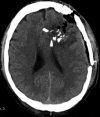Management of penetrating brain injury
- PMID: 21887033
- PMCID: PMC3162712
- DOI: 10.4103/0974-2700.83871
Management of penetrating brain injury
Abstract
Penetrating brain injury (PBI), though less prevalent than closed head trauma, carries a worse prognosis. The publication of Guidelines for the Management of Penetrating Brain Injury in 2001, attempted to standardize the management of PBI. This paper provides a precise and updated account of the medical and surgical management of these unique injuries which still present a significant challenge to practicing neurosurgeons worldwide. The management algorithms presented in this document are based on Guidelines for the Management of Penetrating Brain Injury and the recommendations are from literature published after 2001. Optimum management of PBI requires adequate comprehension of mechanism and pathophysiology of injury. Based on current evidence, we recommend computed tomography scanning as the neuroradiologic modality of choice for PBI patients. Cerebral angiography is recommended in patients with PBI, where there is a high suspicion of vascular injury. It is still debatable whether craniectomy or craniotomy is the best approach in PBI patients. The recent trend is toward a less aggressive debridement of deep-seated bone and missile fragments and a more aggressive antibiotic prophylaxis in an effort to improve outcomes. Cerebrospinal fluid (CSF) leaks are common in PBI patients and surgical correction is recommended for those which do not close spontaneously or are refractory to CSF diversion through a ventricular or lumbar drain. The risk of post-traumatic epilepsy after PBI is high, and therefore, the use of prophylactic anticonvulsants is recommended. Advanced age, suicide attempts, associated coagulopathy, Glasgow coma scale score of 3 with bilaterally fixed and dilated pupils, and high initial intracranial pressure have been correlated with worse outcomes in PBI patients.
Keywords: Medical management; penetrating brain injury; surgical management.
Conflict of interest statement
Figures



References
-
- Esposito DP, Walker JP. Contemporary management of penetrating brain injury. Neurosurg Q. 2009;19:249–54.
-
- Part 2. Prognosis in penetrating brain injury. J Trauma. 2001;51:S44–86. - PubMed
-
- Gutiérrez-González R, Boto GR, Rivero-Garvía M, Pérez-Zamarrón A, Gómez G. Penetrating brain injury by drill bit. Clin Neurol Neurosurg. 2008;110:207–10. - PubMed
-
- Khalil N, Elwany MN, Miller JD. Transcranial stab wounds: Morbidity and medicolegal awareness. Surg Neurol. 1991;35:294–9. - PubMed
-
- Haddad FS, Manktelow AR, Brown MR, Hope PG. Penetrating head injuries: A trap for the unwary. Injury. 1996;27:72–3. - PubMed

